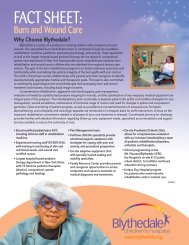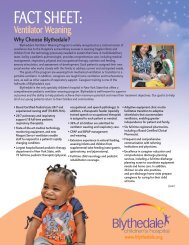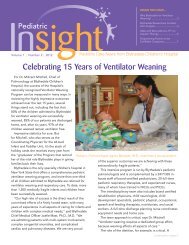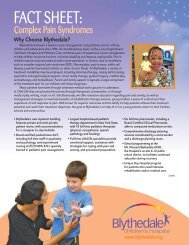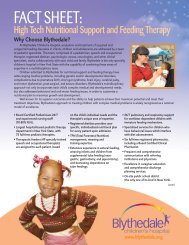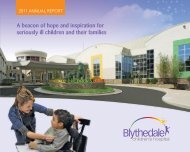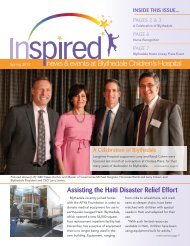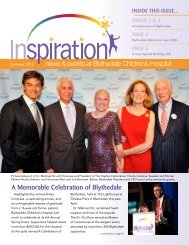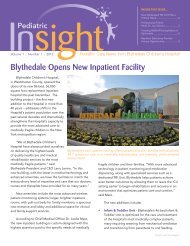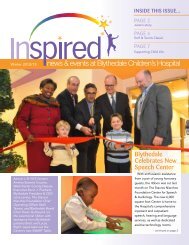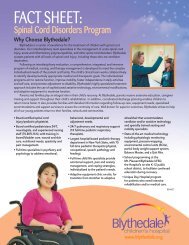2012 Annual Report - Blythedale Children's Hospital
2012 Annual Report - Blythedale Children's Hospital
2012 Annual Report - Blythedale Children's Hospital
You also want an ePaper? Increase the reach of your titles
YUMPU automatically turns print PDFs into web optimized ePapers that Google loves.
Research<br />
Research is a top priority at <strong>Blythedale</strong>. Through its Pediatric Research Program, <strong>Blythedale</strong> conducts<br />
select studies that promise to have a significant impact on treatment modalities for children with<br />
complex medical and physical challenges. Our robust Research program is a natural outgrowth of our<br />
commitment to children and our culture of innovative clinical and multi-disciplinary care. <strong>Blythedale</strong>’s<br />
Scientific Advisory Board, comprised of prominent scientists and pediatric faculty, provides feedback on<br />
our research studies.<br />
In <strong>2012</strong>, <strong>Blythedale</strong>’s Research Task Force identified short and longer term goals, including the vitally<br />
important ongoing development of collaborations with other universities and organizations. To that end,<br />
the Research team identified 39 ideas for future study, and is targeting a “top ten” list which includes<br />
studies on Balance Master intervention, urinary tract infection treatment, the use of nebulized medication<br />
to control drooling in infants, and feeding frequency in children with long-term feeding issues.<br />
<strong>2012</strong> Highlights<br />
• Robotic research continued at <strong>Blythedale</strong>, with<br />
two collaborative studies involving MIT, Riley<br />
Children’s <strong>Hospital</strong>, Rancho Los Amigos, and<br />
New York Medical College. These studies are<br />
looking at key variables that underlie recovery<br />
of motor function, attention to task and<br />
intensity of practice. Participants continue to<br />
show gains in muscle tone following therapy<br />
with the elbow/shoulder and/or wrist robot.<br />
• A team of physical therapists at <strong>Blythedale</strong><br />
continued their gait analysis study utilizing<br />
Balance Master technology. The Balance Master<br />
offers visual feedback to patients as they<br />
stand on different surfaces, challenging and<br />
strengthening components of their balance<br />
skills. This interactive technology is being used<br />
to study walking velocity and check for safe<br />
walking speeds as it relates to crossing a city<br />
street. The team presented their preliminary<br />
findings at the annual meeting of the American<br />
Physical Therapy Association in Florida, in June.<br />
• <strong>Blythedale</strong> began preparation of an exciting<br />
new study to be done in collaboration with<br />
Columbia, Cornell and Burke. This promising<br />
new line of research uses transcranial direct<br />
current stimulation (tDCS) and will be started<br />
in 2013. tDCS is a non-invasive, painless tool<br />
that has been used to stimulate brain activity in<br />
a variety of conditions, including: Parkinson’s,<br />
stroke, and sleep disorders.<br />
• Members of <strong>Blythedale</strong>’s research team were<br />
published in the November <strong>2012</strong> issue of the<br />
American Journal of Physical Medicine and<br />
Rehabilitation. The article, New Horizons for<br />
Robot-Assisted Therapy in Pediatrics, highlights<br />
<strong>Blythedale</strong>’s pediatric study of robot-assisted<br />
therapies for the upper and lower limbs, as well<br />
as potential benefits, challenges and needs for<br />
future development.<br />
3



